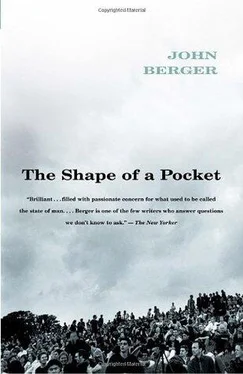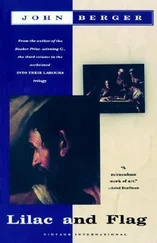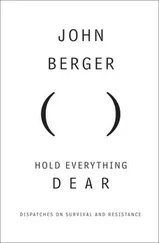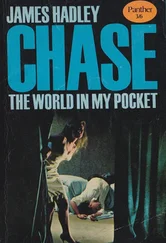Mason’s masterpieces are awkward monuments made during the last quarter of this century to a class that was slowly disappearing, with many of its members forced into terminal unemployment. A class which today scarcely exists but which left the world its own word: solidarity.
I don’t think Mason thought about this as a project; it was in his blood, or, to put it more finely, it was in what he took for granted and worked from.
Return to the church of St Eustace and look again. Look at the guy with a cauliflower and his mate with a Swiss chard under his arm, and the bloke with a big nose holding up a case of oranges as if it were a chalice, and the black kid with a cabbage, and the woman with a pompom hat and cherry lips who is carrying a case of Starking apples which press against her bosom, and the man pulling a wagon, and the tomato which has fallen on to the street and squashed. I look and say to myself: I’ve seen saints in churches and Madonnas and martyrs and the saved and the damned, but I’ve never seen people straight off the street except when they’re sitting on the pews, and here they have a chapel to themselves and have been made sacred! (They themselves wouldn’t believe it. Pull the other leg, it’s got bells on it, they’d say.) Made sacred not by the company of the surrounding saints, nor by the buried generals in their sarcophagi, but by the tenderness of an artist who remembered them with love, and re-created them indefatigably.
They were known as the Elephant and the Butterfly — although her father called her the Dove. When she died, more than forty years ago, she left behind a hundred and fifty small paintings, a third of which are classified as self-portraits. He was Diego Rivera and she was Frida Kahlo.
Frida Kahlo! Like all legendary names, it sounds like an invented one, but wasn’t. During her lifetime she was a legend, both in Mexico and — amongst a small circle of artists — in Paris. Today she is a world legend. Her story has been told and retold very well — by herself, by Diego, and later by many others. Victim of polio as a child, horribly crippled again in a bus accident, introduced to painting and communism by Diego, their passion, marriage, divorce, remarriage, her love affair with Trotsky, her hatred of the gringos, the amputation of her leg, her probable suicide to escape the pain, her beauty, her sensuality, her humour, her loneliness.
There’s an excellent Mexican film about her, directed by Paul Leduc Roseinweig. There’s a beautiful novel by Le Clezio called Diego and Frida. There’s a fascinating essay by Carlos Fuentes which introduces her Intimate Diary. And there are numerous art historical texts placing her work in relation to Mexican popular art, surrealism, communism, feminism. Yet I have just seen something — something you can only really see if you look at the paintings rather than the reproductions. Maybe this thing is so simple, so obvious, that people have taken it for granted. Anyway they don’t talk about it. And so here I am, writing.
A few of her paintings are on canvas, the vast majority are either on metal or Masonite, which is as smooth as metal. However fine the grain of a canvas, it resisted and diverted her vision, making her brush strokes and the contours she drew too painterly, too plastic, too public, too epic, too much like (although still so different from) the Elephant’s work. For her vision to remain intact, she needed to paint on a surface as smooth as skin.
Even on days when pain or illness forced her to stay in bed, she spent hours every morning dressing and making her toilette. Every morning, she said, I dress for paradise! Easy to imagine her face in the mirror with her dark eyebrows which naturally joined, and which with her kohl crayon she emphasised and transformed into a black bracket for her two indescribable eyes. (Eyes you remember only if you shut your own!)
In a comparable way, when she painted her pictures, it was as if she was drawing, painting or writing words on her own skin. If this were to happen there would be a double sensitivity, because the surface would also feel what the hand was tracing — the nerves of both leading to the same cerebral cortex. When Frida painted a self-portrait with a little portrait of Diego painted on the skin of her own forehead and on his forehead a painted eye, she was surely confessing — amongst other things — to this dream. With her small brushes, fine as eyelashes, and with her meticulous strokes, every image she made, as soon as she fully became the painter Frida Kahlo, aspired to the sensibility of her own skin. A sensibility sharpened by her desire and exacerbated by her pain.
The corporeal symbolism she used when painting body parts like the heart, uterus, mammary glands, spine, to express her feelings and ontological longing, has been noticed and commented upon many times. She did this as only a woman could, and as nobody else had done before. (Although Diego in his own way sometimes used a similar symbolism.) Yet it is essential to add here that, without her special method of painting, these symbols would have remained surrealist curiosities. And her special method of painting was to do with the sense of touch, with the double touch of hand and of surface as skin.
Look at the way she paints hairs, either those on the arms of her pet monkeys or her own along the hair-line of her forehead and temples. Each brush mark grows like a hair from a pore of the body’s skin. Gesture and substance are one. In other paintings drops of milk being expressed from a nipple or drops of blood dripping from a wound, or tears flowing from her eyes, have the same corporeal identity — that is to say the drop of paint does not describe the body liquid but seems to be its double. In a picture called Broken Column her body is pierced by nails and the spectator has the impression that she was holding the nails between her teeth and taking them one by one to tap in with a hammer. Such is the acute sense of touch which makes her painting unique.
And so we come to her paradox. How is it that a painter so concentrated on her own image is never narcissistic? People have tried to explain this by quoting Van Gogh or Rembrandt, who both painted numerous self-portraits. But the comparison is facile and false.
It is necessary to return to pain and the perspective in which Frida placed it, whenever it allowed her a little respite. The capacity to feel pain is, her art laments, the first condition of being sentient. The sensitivity of her own mutilated body made her aware of the skin of everything alive — trees, fruit, water, birds and — naturally — other women and men. And so, in painting her own image, as if on her skin, she speaks of the whole sentient world.
Critics say that Francis Bacon’s work was concerned with pain. In his art, however, pain is being watched through a screen, like soiled linen being watched through the round window of a washing machine. Frida Kahlo’s work is the opposite of Francis Bacon’s. There is no screen; she is close-up, proceeding with her delicate fingers, stitch by stitch, making not a dress, but closing a wound. Her art talks to pain, mouth pressed to the skin of pain, and it talks about sentience and its desire and its cruelty and its intimate nicknames.
One finds a comparable intimacy with pain in the poetry of the great living Argentinian poet, Juan Gelman.
that woman begs for alms in a twilight of pots and pans
that she’s washing furiously / with blood / with oblivion / to ignite her is like putting a gardel record on the phonograph /
streets of fire fall from her unbreakable barrio /
and a man and a woman walking tied
to the apron of pain we put on to wash /
Читать дальше












